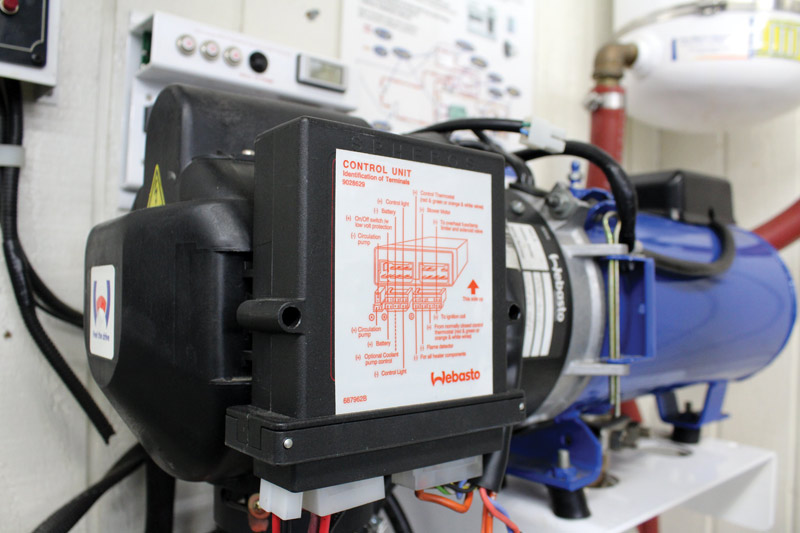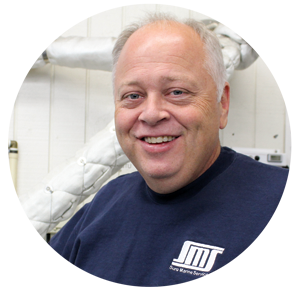“When the water starts boiling,
it is foolish to turn off the heat”
—Nelson Mandela
One doesn’t have to be a boater to know that the Pacific Northwest is quite a bit colder this time of year. Fortunately for local boaters, we are spared the truly brutal winters of the Midwest and East Coast, and for most of us, boating in the winter is par for the course. How else are we to fill the crab pots for that special holiday feast, or experience the San Juans at their most authentic without the seasonal crowds? Regardless of your winter boating priorities, a heating system is a must.
Now that it’s December, heating systems of landlubbers and old salts alike are being dialed in across the region. We thought it’d be an appropriate time to explore the topic of vessel heating systems, and the Seattle-based Sure Marine Services, Inc. is a Pacific Northwest standout. Located in the marine Mecca of Seattle’s Ballard neighborhood on the banks of Salmon Bay, the company has been a primary go-to source of professional advice (usually free), parts (many of which they fabricate in-house), and entire vessel heating systems since the early 1980s.
We met with Eric Hinze, president and co-owner of Sure Marine Services, Inc., bright and early before work hours in his office to pick his brain about vessel heating. Hinze joined the company as a fire extinguisher technician in 1984. He worked his way up the ladder through the decades to the president’s chair, where he sits today.
Q: It sounds like every job has a custom element, in a way?
Sort of, yes. Manufacturers will have a standard kit that they’ll order from us for a specific build, but the individual owners can differ from each other. Often boat owners are just looking for parts, and we can fabricate them in the shop if we don’t have them on hand.
We want to be sure boaters get the right equipment and make safe choices. A lot of the time, we get a call from somebody who bought a cheap heater independently and wants our advice on installation and necessary additional parts. We often look at what they bought and end up advising them not to use the heater they purchased because it could burn their boat down. That type of thing.
One of the most important elements of a heating system is where to put the exhaust. If you can’t locate a good spot for the exhaust, it makes it hard to put a heating system in there. The biggest limitation is the length of the exhaust. You don’t want to fill up a large exhaust with seawater that ruins the heater, but you don’t want to install it incorrectly and not wake up in the morning due to carbon monoxide poisoning.
I always make sure that my clients have a working carbon monoxide detector on board. You’re supposed to have one anyway, but I just make sure it’s installed correctly, is working, etc. We sell carbon monoxide detectors at wholesale prices because we just want boaters to have them to be safe. Everybody needs one, end of discussion.
Service, Inc.
Ballard-based Sure Marine Service Inc. was incorporated in 1982 and has been a highly-regarded vessel heating specialist for decades. These days, their services have expanded to include vessel air-conditioning systems, refrigeration, galley stoves, and propane units. Their clients include the U.S. Coast Guard, police departments, and local maritime search and rescue organizations who require the best heating systems to save lives.
suremarineservice.com // 828-404-3112

Q: It sounds like it’s one thing to do it yourself with varnishing wood trim and the like, but the ramifications of installing a heating system incorrectly are pretty serious.
Yup. My partners and I talk about this all the time. Everybody sells equipment that can possibly kill somebody if not installed correctly.
We’ve always written our own installation manuals for our heaters, and I can go back decades in our records to look at the old ones. Anytime we see something, or hear something from a dealer or customer, we’ll take that under consideration and improve the manual as part of its evolution.
Q: What kind of heating systems do you sell the most of to the recreational sphere? You do commercial as well, correct?
Yes, we do commercial and planning for builders, brand new yachts, and the like. We also manufacture many system parts and accessories.
Q: You make a lot of that stuff in-house?
Yes, we make a lot of that stuff in-house in our shop. When we can’t make it in-house, we work with specialized dealers. We also have a very large number of parts in stock, so unless the part is really out there, we usually have it on hand.
Q: Is propane a main part of the vessel heating industry?
Diesel heating systems are the bread and butter of what we do here.
Q: Are there specific advantages to diesel heating systems?
There are quite a few pluses to diesel systems. Firstly, diesel is easy and safe to carry aboard, while propane is significantly less safe and convenient.
Diesel is also more efficient, and delivers roughly 145,000 Btu (British thermal unit [unit of energy; 1 Btu is roughly equal to .29 watt hours, 1.054 to 1.060 kilojoules, or 250 calories]) per gallon, while propane delivers about 92,000 Btu per gallon. You get more heat per gallon with diesel.
The cost of diesel to propane per gallon is roughly equal right now. Diesel is more readily available at a fuel dock. Some of the gas-powered boats may get by with a propane system, especially if they’re not out as long. Cruisers or workboats are typically diesel, which also comes in handy at the dock.
If you’re at the dock for extended periods of time, there’s a limit to what the 30-amp or whatever shore power can deliver. If you’ve got your hot water heater and microwave both going, you’re probably maxed out. A lot of guys try to heat with only electric heat, but that shore power cable can get hot!

Eric Hinze has been working with Sure Marine Services since 1984 when he joined as an entry-level fire extinguisher technician. He worked his way up the ranks over the decades from service technician positions to management. He now is the president and one of the co-owners of the company. When asked how many other businesses do what Sure Marine Services does, he said with pride, “None. I get a handful of letters every week of folks trying to buy the company.”
Q: One hears a lot about the Webasto vessel heating systems. Is there a reason why? Are they doing something that the other companies aren’t?
Webasto has largely been regarded as the gold standard in the industry for years. When you compare other heaters to their heaters, one can see the technological advancements in the Webasto models. They are usually one or two steps ahead.
Olympia is another successful large heating system company. It’s a USA-made boiler from the East Coast and we carry their 60,000-Btu and 105,000-Btu models. Those are good for large yachts, like the bigger Hamptons.
I see a lot of heaters coming out of other countries now with the philosophy that they can sell it to you cheap for $500, but the technology is 15 or 20 years old. It’s often not well put-together, and even dangerous with no installation support. People from all over come to us and want us to carry their products, but we test them out and they don’t pass our sniff test. There’s a pile of models behind that door that we’re never going to sell, usually because they aren’t safe. We only carry safe products.
Q: Are there some giveaways to look out for in terms of an unsafe product?
When you go to look at a heating system, and you visit a business or something, a warning signal is if they can’t supply you with everything. “Here’s the heater, go buy everything else and put it in yourself,” kind of thing. We get a lot of people coming in asking questions about a certain heater they bought, and we try to give them the best advice about how we’d go about it.
Q: You mentioned Btu. Is there a general rule of thumb, like a ratio, of Btu per square foot of space?
Yes, there are some rules of thumb in the industry that use cubic footage. For a powerboat, the general rule is cubic footage times 15. The general rule is times 12 on a sailboat. On a sailboat, there’s relatively few window areas and the interior is positioned down inside the hull; it’s not as exposed.
If I do a calculation that involves a large yacht, the lower decks will require cubic footage times 12, while the upper decks with windows need cubic footage times 15. If it’s a real cold-weather boat that’s going to spend time in Alaska, we’ll go with cubic footage times 18 to make sure we’ve got it all covered.
Boats are not insulated like a building. A building always has one side in the shade and the other in the sun. The newer, bigger yachts have good insulation, but it’s nothing like how a building has.
Also, anything aluminum, from window frame to an aluminum hull, every square inch that’s exposed both inside and outside equates to roughly 7 to 11 Btu of heat gain or loss. If you’re trying to air condition or heat the boat, you must calculate that into account. Aluminum is a great conductor of heat, meaning that it transfers heat very quickly, but does not retain the energy like other materials. In fact, all the fins of our heater cores are made of aluminum for that reason.
Q: What does good yacht insulation usually look like?
Usually yacht insulation is a closed-cell foam, a black material that varies in thickness. It’s closed-cell to keep moisture and the like from getting in there. There’s now new spray-on stuff to help with the insulation of the hull. A key factor that people sometimes don’t remember is that insulation just slows down the loss or gain of heat. It’s not going to keep it all in there indefinitely.
Q: Do you get an uptick in heating sales this time of year? Is there a seasonality to your business?
For heating, definitely. These days, now that we’re also selling air conditioning, we’re a lot more diversified. The slowest time for us is the summer, where for most marine businesses that’s the busiest time because everyone is using their boats. People still use their heaters around here during the summertime, though. The evenings can still be chilly. People always heat hot water aboard too.
Q: Is there a line of heaters that are the go-to workhorse of the recreational sphere?
The big hydronic heating systems, like the larger Webasto’s and Olympia’s, are popular with the larger yachts and liveaboards. For smaller boats that aren’t liveaboards, hydronic systems are less necessary.
Hydronic systems take a bit longer to get started because it heats up the fluid to circulate throughout the boat. Once that fluid is warm, it takes a long time to cool that fluid off. Even when the heater is off, there’s still a lot of warmth feeding into the boat.
Q: Can you speak about the hydronic systems? How do they work?
What we do with our hot water systems is use a fluid mixture of about 70% water and 30% antifreeze. The fluid is moved about the boat to a series of fan heaters from our product line. We sell well over 70 different units, models, and variations. They’ll fit into different compartments and will each put out anywhere from a couple thousand Btu’s to upwards of 25,000 or 30,000 Btus. The warmed fluid circulates throughout the boat and is very effective at heating up the vessel.